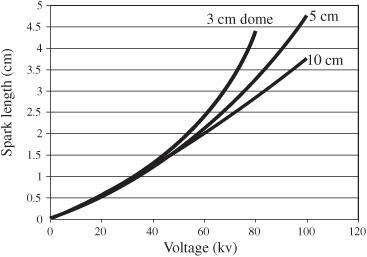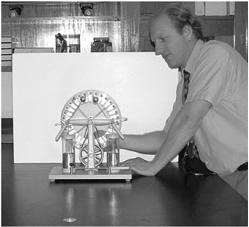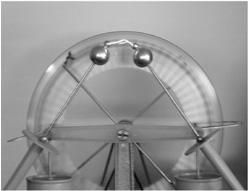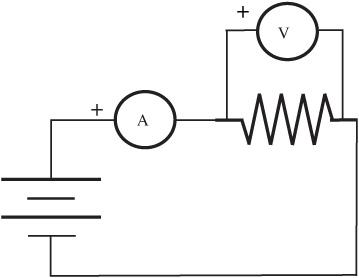125 Physics Projects for the Evil Genius (58 page)
Read 125 Physics Projects for the Evil Genius Online
Authors: Jerry Silver

4. Position the neon bulb parallel to the floor on a line pointing toward the center of the conducting sphere. Move it closer and further from the van de Graaff and observe.

Figure 97-2
Lighting a neon bulb by exposing it to an electric field
.
5. Position the neon bulb parallel to the floor on a line pointing perpendicular to the circumference of the conducting sphere, as shown in
Figure 97-2
. Move it closer and further from the van de Graaff and observe.
Expected Results6. Turn the generator off and ground the conducting sphere with the ground electrode to remove any residual charge.
Sparks will discharge through the air. Longer sparks are generated if the voltage is high and the humidity is low. Best-case spark length is shown in
Figure 97-3
.

Figure 97-3
Spark length. Based on data from A. D. Moore
, Electrostatics: Exploring, Controlling, and Using Static Electricity
(New York: Doubleday-Anchor, 1968
).
An electrical motor drives a nonconducting belt that separates positive and negative charges. Negative charges are drawn away from the conducting metal sphere at the top of the device, leaving a static positive charge on the sphere. Bringing a neutral or negatively charged object close to the conducting sphere results in a discharge in the form of a lightning-like spark through the air. The maximum length of the spark depends on the relative humidity in the air. As a rule of thumb, the spark jumps about 1 centimeter for every 10,000 volts that build up.
Objects that come into contact with the conducting sphere, themselves become charged. This causes repulsion between pieces of paper taped to the conducting sphere, of the hair of a person touching the sphere (while standing on an insulating surface), and between small objects, such as Styrofoam chips or Rice Krispies that come into contact with the sphere.
Charges separated by the van de Graaff generator can be concentrated on the bulb of an electroscope. The sign of the charge can be determined by observing the effect of a charged rod brought near the bulb. If the charge is the same, the leaves of the electroscope are driven further apart. If the charge is different, the leaves are drawn closer together. A positively charged rod results by rubbing wool or fur on rubber. A negatively charged rod results by rubbing silk on glass.
Use of a
tesla coil
is another way to generate sparks that jump through the air. These can be purchased as hand-held units.
This experiment shows how, through the movement of dissimilar materials against each other, static electric charges can build up. An electric field is established in the region separating the electrical charges which can force the electrons to move.
The Wimshurst machine. Separating and storing charges
.
The
Wimshurst machine
, like the van de Graaff generator, is capable of throwing long sparks as much as several centimeters between two small conductive spheres. The Wimshurst machine is usually also tied to a Leyden jar, which presents a good opportunity to explore capacitance and charge storage.
- Wimshurst machine
- CAUTION: Electrical circuitry including pacemakers, hearing aids, cell phones, flash drives, electronic car door locks, and computers may be damaged by the sparks generated in this experiment.
In addition, follow all safety instructions provided by the manufacturer of this device
. - Set the Wimshurst apparatus on a table.
- Darken the room.
- Make sure all electrical jumpers are in place for your particular setup. Check with the manufacturer’s instructions to make sure the apparatus is set up properly with correct electrical paths to the Leyden jars and discharge spheres. You can do this both with the Leyden jars connected or not connected to your circuit.
- Separate the two discharge spheres by more than 8 cm.
- Turn the handle for five seconds or so, as shown in
Figure 98-1
. - Holding only the insulated wooden handles for the discharge spheres, slowly bring them together.
- Note the distance between the discharge spheres when the first discharge occurs.
- Set the discharge spheres at roughly the same slightly closer and slightly further distances.
- If the Leyden jars were in your circuit, repeat to see what happens when they are not connected.
- Touch the two spheres together for a few seconds when finished to make sure no residual charges are on the electrodes.

Figure 98-1
Chris Aleo demonstrates the operation of a Wimshurst machine
.
With the discharged spheres separated by a large distance, nothing should happen.
As the spheres approach to within a few centimeters separating them, a lightning bolt will jump across the gap, as shown in
Figure 98-2
.
The Wimshurst machine is constructed from two parallel plates made from insulating material such as Lucite or glass. The plates are arranged to be turned by hand in opposite directions. Narrow metal strips are mounted on the plates and oriented along the radius. Charges are transferred by metal brushes that sweep across the metal strips as the plates rotate. In contrast to the van de Graaff generator, the Wimshurst machine separates charge by the principle of induction rather than friction. Positive and negative charges accumulate, and they can either charge a Leyden jar or discharge across a gap.

Figure 98-2
Wimshurst machine electrical discharge
.
Charges separated by the Wimshurst machine can be determined using an electroscope, as described in the previous experiment.
This experiment shows how, through the movement of two insulating plates near each other, static electric charges can build up. The separated charges can be stored or discharged across a small nonconductive gap.
Running into resistance. Ohm’s law
.
Ohm’s law
forms the basis for understanding how electricity flows through circuits. This is a very simple relationship that involves three things: 1) the
voltage
or the push that move electrons through the circuit, 2) the
current
(or amps), which is a measure of how much electricity is flowing through that circuit as a result of that push, and 3) the
resistance
(in ohms), which does all it can to make it difficult for the electricity to flow.
Because of its simplicity, this experiment is a good one for you to discover the law for yourself, based on your measurements.
- one 100 ohm resistor rated for 0.5 watt (other resistor values can work, but the resistor must be rated to handle the wattage that will be applied to it; the wattage is supplied by the resistor manufacturer and is often marked on the resistor)
- ammeter
- voltmeter
- DC power supply (or battery)
- wires to connect to battery terminals
- Connect a circuit, as shown in
Figure 99-1
. This is a circuit consisting of a resistor in series with a DC power supply and an ammeter with a voltmeter connected by jumper wires to each of the ends of the resistor. A drawing called an
electrical schematic
is shown in
Figure 99-2
. This is equivalent to
Figure 99-1
, but it shows the electrical connections without regard to the actual physical layout of the components. - Turn the DC power supply to zero.
- Set the ammeter to read milliamps. Set the voltmeter to read 0–10 volts.
- Increase the DC power supply to give a voltage reading of 0.2 volt.
- Read the current.
- Do the same with a voltage of 0.4, 0.6, and 0.8 volts.
- Graph current versus voltage. Draw a line that best fits the data. What is the significance of the slope of the line?
- Repeat this with a 200 and a 300 ohm resistor.
For a given resistor, the greater the voltage, the more current flows.
As resistance increases, less current flows for a given voltage.

Figure 99-1
Circuit for measuring Ohm’s law
.
